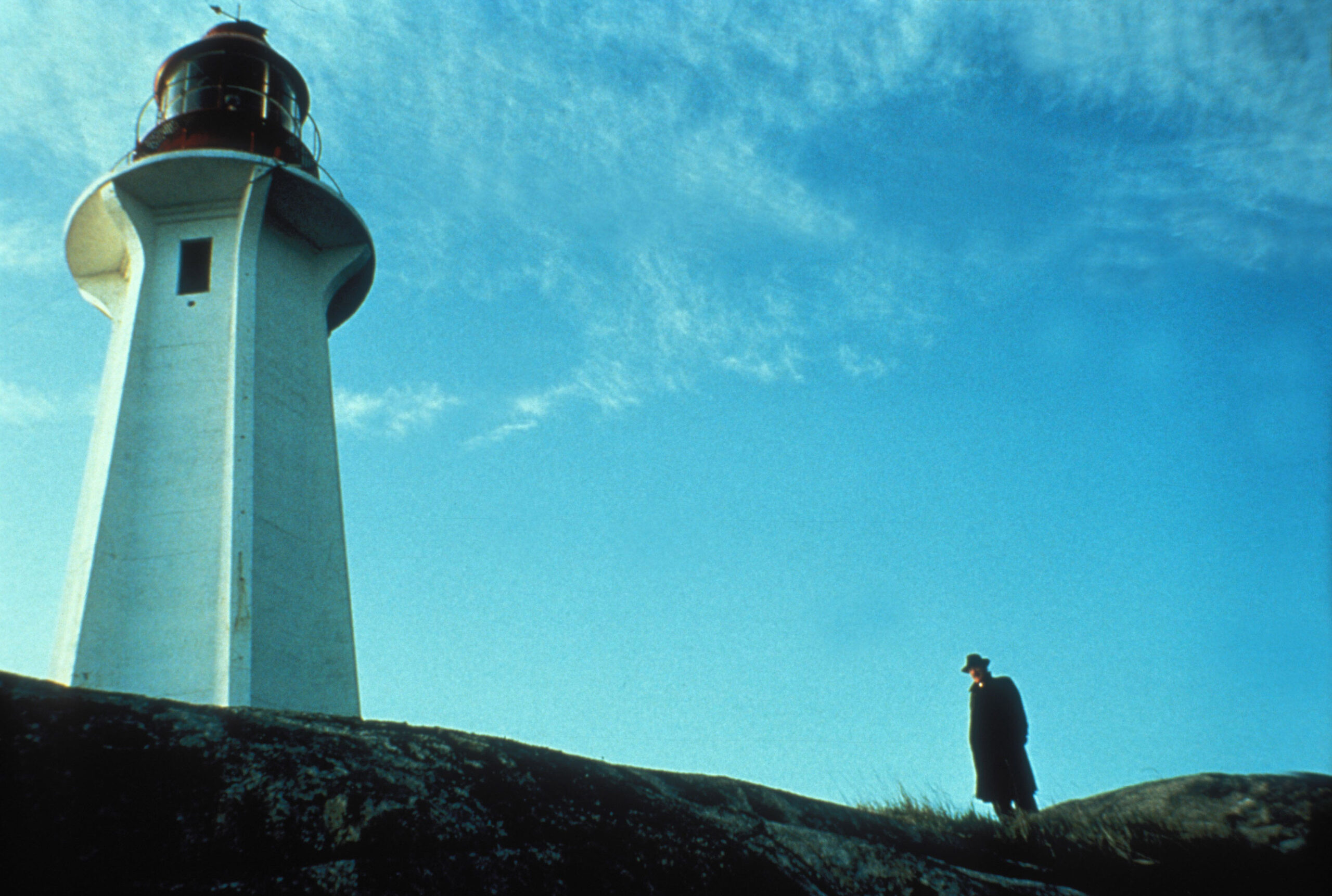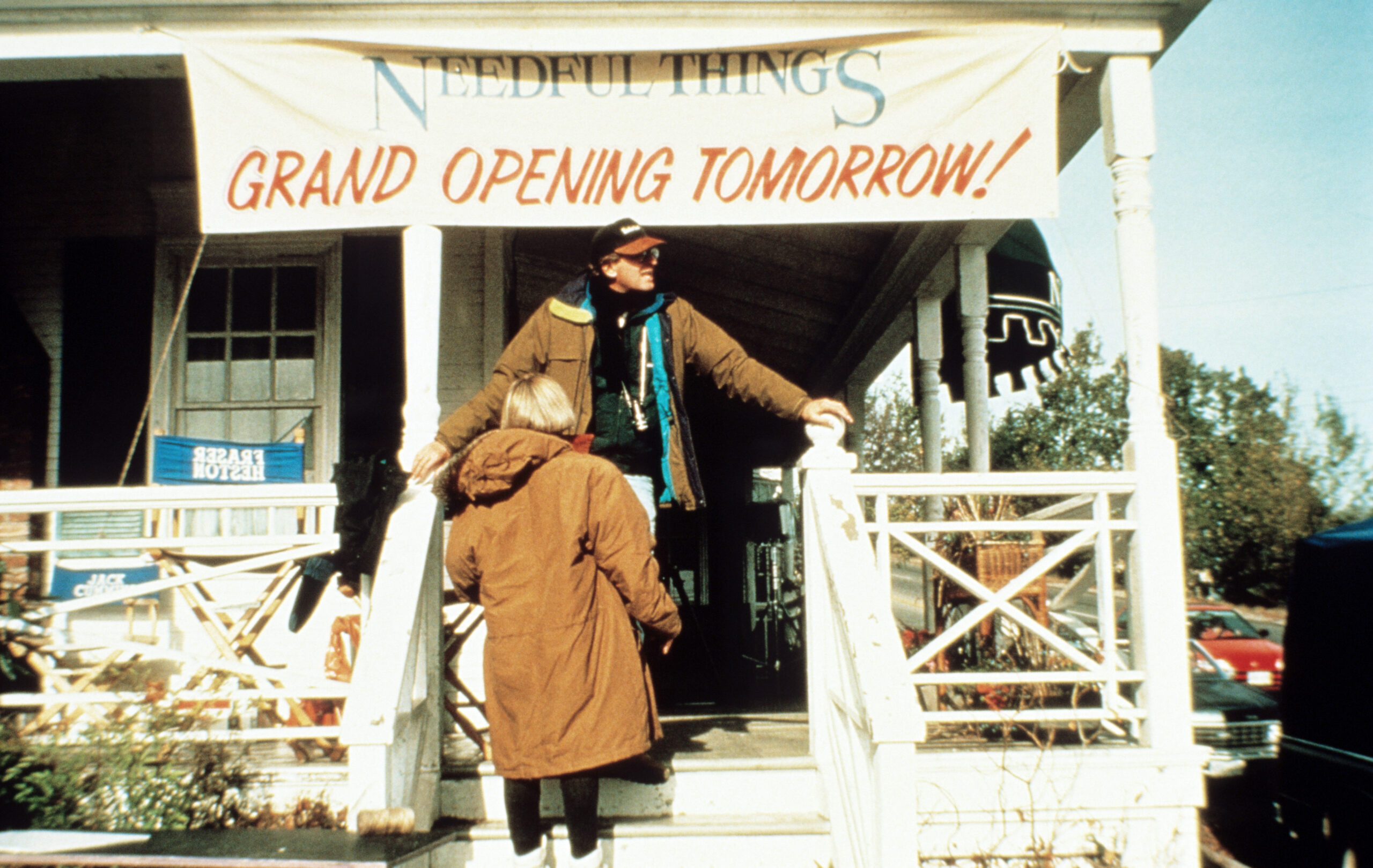Author Stephen King has long been associated with his home state of Maine. The fictional Maine towns of Derry and Castle Rock recur throughout the horror icon’s work. It may then surprise some to learn how vital B.C. has been in establishing the geography of early King adaptations, namely TV projects from the 1990s.
In It, six adults return to Derry to face the nameless monster that tormented them in childhood. In Needful Things, a mysterious shop opens in Castle Rock, offering customers anything they want—for a price. Both the TV miniseries Stephen King’s It (1990) and the film adaptation of Needful Things (1993) used British Columbia to stand in for Maine: Vancouver, Burnaby, and New Westminster in It and Gibsons in Needful Things. Both featured a mixture of Hollywood actors and local talent, and both had memorable villains, with Tim Curry as the evil clown Pennywise and Max von Sydow as the devilish Leland Gaunt. These two early ’90s productions brought King’s work to new audiences, all the while establishing B.C. as an unlikely visual parallel for New England as well as an ideal location to film stories of horror and the supernatural.
The screenplay for It was written by Lawrence D. Cohen, who had previously adapted King’s novel Carrie. It was originally conceived as an eight-to-10-hour miniseries with Night of the Living Dead’s George Romero set to direct, but the ABC network “lost their nerve,” according to Cohen, and cut the project to four hours, broken up over just two nights. The first night would focus on the characters terrorized by Pennywise as children in the 1950s. The second night would follow their return to Derry as adults to face down the evil clown once and for all. Tommy Lee Wallace (who edited Halloween and The Fog) was hired to direct, and he rewrote the second night’s episode to bring the story more into line with King’s novel.
Casting the seven members of the Losers Club involved finding both children and adult versions of the characters. “We cast Jonathan Brandis and Seth Green from Los Angeles,” Wallace said of the kids. “Most of the others came from Canada,” including Vancouver’s Emily Perkins, who would go on to star in Ginger Snaps. The adults were played by veteran TV actors including John Ritter and Annette O’Toole. For the role of Pennywise, the producers considered Malcolm McDowell, Roddy McDowall, Harvey Fierstein, and Alice Cooper before offering the role to Tim Curry.
“The movie, really, is only as good as its villain,” Wallace said in Back to Derry: An Oral History of Stephen King’s It Miniseries, “and Tim carved out a place for himself as one of the great movie villains of all time.”

Tim Curry as Pennywise the Clown in Stephen King’s It (1990).
Filming in the Lower Mainland took three months and found the crew shooting at Bridge Studios in Burnaby, as well as on location. New West’s Paramount Theatre features in the opening frames of the miniseries, its marquee advertising I Was a Teenage Werewolf. The scene in which an aged postcard of Pennywise comes to life was filmed at Burnaby Village Museum in Deer Lake Park. The forest scenes were shot around the Buntzen Lake powerhouse, where Pennywise’s lair is, and at Beaver Lake in Stanley Park. Homes in East Van and New West served as the characters’ residences. “In ’89, it was really busy in town,” assistant director Patrice Leung said in the 2022 documentary Pennywise: The Story of It. Annette O’Toole remembered that the adult cast “all stayed in this cool apartment building by Stanley Park and had a lot of fun together.”
Vancouver weather presented a challenge but proved to be a blessing in disguise when filming Pennywise’s first appearance. In the scene, a small boy (Tony Dakota) follows a paper sailboat along a rainy gutter (filmed on Third Street in New West) until he comes upon the monster lurking in a storm drain. “We all float down here,” Pennywise utters, before attacking. Tim Curry recalled the child actor telling him, “Tim, you’re scaring me!” to which Curry replied, “It’ll save you a little acting, won’t it?” In the scene, streaks of sunlight appear through the artificial rain. “You can almost always count on overcast in Vancouver,” Wallace said in Pennywise: The Story of It. “But this day was sunny and bright,” noting that, “The effect was kind of wonderful.”
Stephen King’s It was a ratings success, reportedly watched by 30,000,000 people, and received critical acclaim, especially for Curry’s performance. Ken Tucker wrote in Entertainment Weekly that “the cast is terrific, Curry’s cackle is chilling, and King’s usual buried theme—about the pain adults inflict on children without even realizing it (It?)—is always worth pondering.” In The New York Times, John J. O’Connor called It “far better than any adaptation so far of a King book.” The author himself liked it as well: “My expectations were in the basement,” King admitted. “But the series really surprised me by how good it was. It’s a really ambitious adaptation of a really long book. The kid actors were good, and the adult actors were terrific.” It ranks second on Collider’s list of best horror miniseries and sixth on IMDB’s. The success of It led to wider acceptance of horror on television and paved the way for more King adaptations—including Needful Things.
King envisioned Needful Things as “a satire of the whole Ronald Reagan ethos of ‘greed is good, consumerism is good.’” The devil comes to Castle Rock in the form of shopkeeper Leland Gaunt, who offers the townsfolk objects that fulfill their secret desires. In return, Gaunt enlists them to perform pranks on the other residents, exacerbating local rivalries into murder and mayhem. As with It, Lawrence Cohen adapted the novel, but according to Steve Newton of Fangoria, the producers didn’t like Cohen’s version and replaced him with W.D. Richter, who cowrote Big Trouble in Little China. Fraser C. Heston, who had directed his father, Charlton Heston, in The Crucifer of Blood, was chosen to direct.
Max von Sydow, star of The Exorcist and The Seventh Seal, played Leland Gaunt. “I’m trying to play Gaunt the way Stephen King has written him,” von Sydow told Newton. “He is portrayed as a very nice man, as a very urbane and courteous and charming man … and he personally doesn’t really do anything. He manipulates other people.” Gaunt’s machinations breed mistrust between Sheriff Alan Pangborn (Ed Harris) and fiancée Polly Chalmers (Bonnie Bedelia), stoke paranoia in mayor Danforth Keeton (J.T. Walsh), and escalate a feud between a turkey farmer (Valri Bromfield) and a waitress (Amanda Plummer) into a horrific knife fight.

The Point Atkinson Lighthouse featured in Needful Things (1993).
Needful Things was filmed in Gibsons on the Sunshine Coast, where CBC’s long-running The Beachcombers was also filmed. Production designer Douglas Higgins, who had worked on It, helped transform the town into Castle Rock. The Point Atkinson Lighthouse on Burrard Inlet is featured in the film’s opening shot. Molly’s Reach, the diner on School Road featured in The Beachcombers, was turned into the Dot Café, while a church exterior was constructed overtop a tourist info booth. The location where the Needful Things store was built—and spectacularly demolished—was 529 Gibsons Way. “In the middle of the night they blew it up,” Steve Sleep of Eastlink TV recalled for the Sunshine Coast Museum. “The fire department was on standby, they locked down the whole town, and there were police everywhere. Meanwhile, the church was on fire at the same time. It was quite a big deal.”
Reviews for Needful Things were generally unfavourable. Roger Ebert described it as “Satanic water torture,” though he admitted von Sydow “plays the devil about as well as anyone could.” More recently, Den of Geek also praised von Sydow’s performance: “The film lights up, sometimes quite literally, whenever he’s onscreen and he’s a great villain in a classic, dastardly way.” In 1996, an extended cut of the film was shown on TBS in a two-night broadcast, similar to It. Kino released both versions on Blu-Ray and 4K in 2023.
Special effects artist Tony Lazarowich said that in terms of film production, It “put Vancouver on the map.” Many familiar B.C. actors got their start in these two Stephen King adaptations: It features early performances from Venus Terzo and The X-Files’ William B. Davis and Megan Leitch, while Lochlyn Munro and Campbell Lane appear in Needful Things. Frank C. Turner appears in both: as Bev’s father in It and as Wanda’s husband in Needful Things. The popularity of Stephen King adaptations in the early ’90s, especially It, emboldened networks and studios to produce more horror series and films, laying the foundation for Netflix staples like Stranger Things and The Haunting of Hill House, as well as King adaptations such as Castle Rock and the 2017 and 2019 film versions of It. In 2025, a prequel series titled It: Welcome to Derry will appear (shot in Ontario, alas) as a Max streaming original. Derry and Castle Rock may only exist in the imagination, but in the 1990s their dark history ran through B.C., which was in turn reflected back into them, reshaping their legacies along the way.
Read more local film stories.









